DISCOVERING PORTUGAL: Belém & Lisbon
Pastéis de nata, tremors and saudade at the Gateway to History
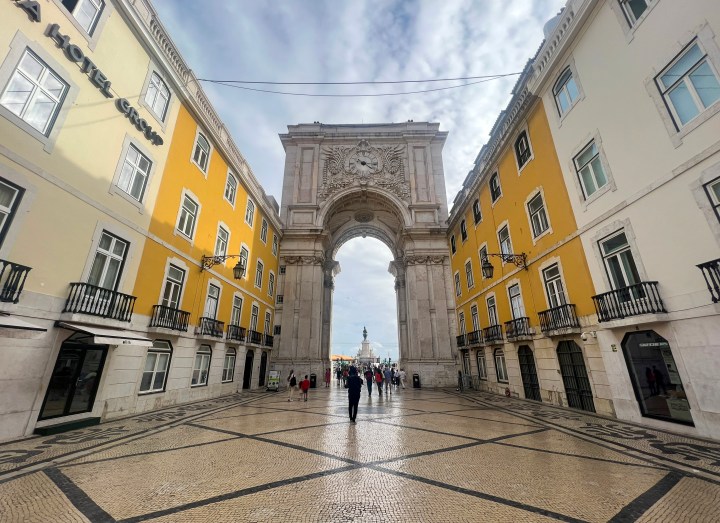
Portugal discovered the world. Now the world is discovering Portugal. Like a child in a pastéis de nata shop, I devoured everything in sight and wished I could come back for seconds.
Standing on the Terreiro do Paço, the Gateway to Lisbon, while wind gusts around you and the waters of the Tagus chop and spew like Table Bay while the Cape Doctor is having one of his blustery tantrums, you try to imagine the scene here when one of history’s most notable earthquakes struck Lisboa.
This was 1755, more than 200 years after the end of the country’s two periods of exploration to conquer foreign lands from Brazil and the Açores (the Portuguese spelling) to Cape Verde, Goa and Macau, Angola and Mozambique.
Hordes of the city’s denizens had run towards the comforting banks of the river they call Tejo (Tagus in English) to find relief. They huddled there, shivering, shaking and fearful, imagining or hoping that the worst was over.
Then the waters receded, mysteriously. Forty minutes later, the sea rushed back into the river with vengeful force to sweep many of them away, while others raced their horses towards higher ground and safety.
But nature was not yet done with her work. Once the waters had receded, and with tremors still unsettling the remaining buildings, candles lit in homes all over the city to mark All Saints Day toppled over. Soon, fire roared through the city to asphyxiate many of those residents who had somehow survived.
Was this vengeance? It is recorded that some Lisboetas of the time believed that the nation was being punished for ills they had committed in foreign territories. The event was certainly more impactful than its brutal physical devastation.
It is the earthquake that gave birth to modern-day seismology.
Not for nothing is King Dom José I, who survived the ’quake, mounted on horseback in the statue of him that dominates the square today. Although nothing really dominates this extraordinary space; it’s the space itself, the scale and foreverness of it, that dictates your response to it. It seems to have an energy of its own as you forge across it one way or another.
On the flanks are magnificent palatial buildings recently repainted in the cheerful ochre of their origins, but your overall impression is of commandment. The Terreiro do Paço seems to have power over you; it will have you feel its presence and impose its history upon you. You’re taken out of your present and deposited in its past, until you wander back through the arch of the Arco da Rua Augusta again and traipse back to your car, having been lost in an ancient world.
The arch was erected to commemmorate those who rebuilt the city after the earthquake, not least the prime minister, Marquês de Pombal, who was tasked by the king to oversee the reconstruction. Pombal is celebrated throughout the modern city today, in roads, buildings and even a hotel.
But let’s turn back again to the Terreiro do Paço and stroll to the water’s edge. A pair of seagulls swoop and sweep above you in a macho airborne fight, using their wingtips to smack the other away. As you approach the water, at first you presume it to be the sea. It’s that wide. You’re facing a pair of identical columns on which are perched seagulls standing sentinel in their riverside domain. The pillars are the Cais das Colunas and have borne witness to great people and greater ships who have visited Lisbon and departed from it.
I felt as though I was standing at the Gateway to History.
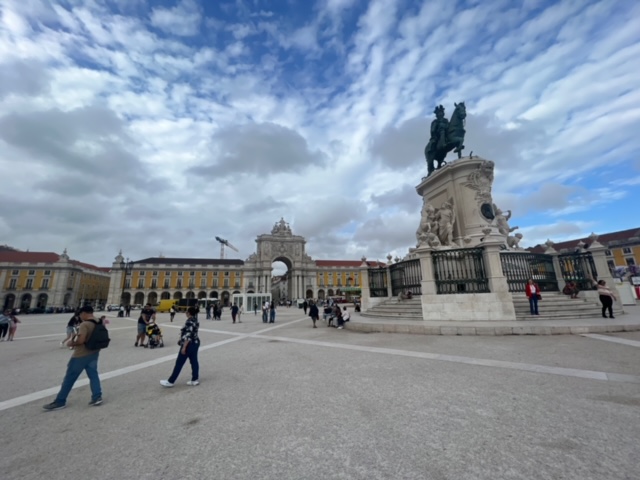
Terreiro do Paço with its 1775 statue of King Dom José I, who briefed prime minister Marquês de Pombal to rebuild Lisbon after the terrible earthquake of that year. Terreiro do Paço is one of the largest squares in Europe and used to be the site of the palaces of the country’s kings. (Photo: Tony Jackman)
The discoverers left from here to find faraway territories to claim for Portugal. The wind, the salt and the history conspire to have you imagine you were there when the modest caravels took to the wild waters on an insane quest to conquer lands for the crown. A madness that spawned an empire once admired and now picked apart as history is inspected for abuse of power.
Despite any misgivings the modern visitor may have, with the changed perspective that subsequent history has given us, you cannot but be left with an impression of respect for the courage and daring of the ancient Portuguese, even as questions hover in the wuthering air about distant people once enslaved and the colonial hangover now being explored by their descendants.
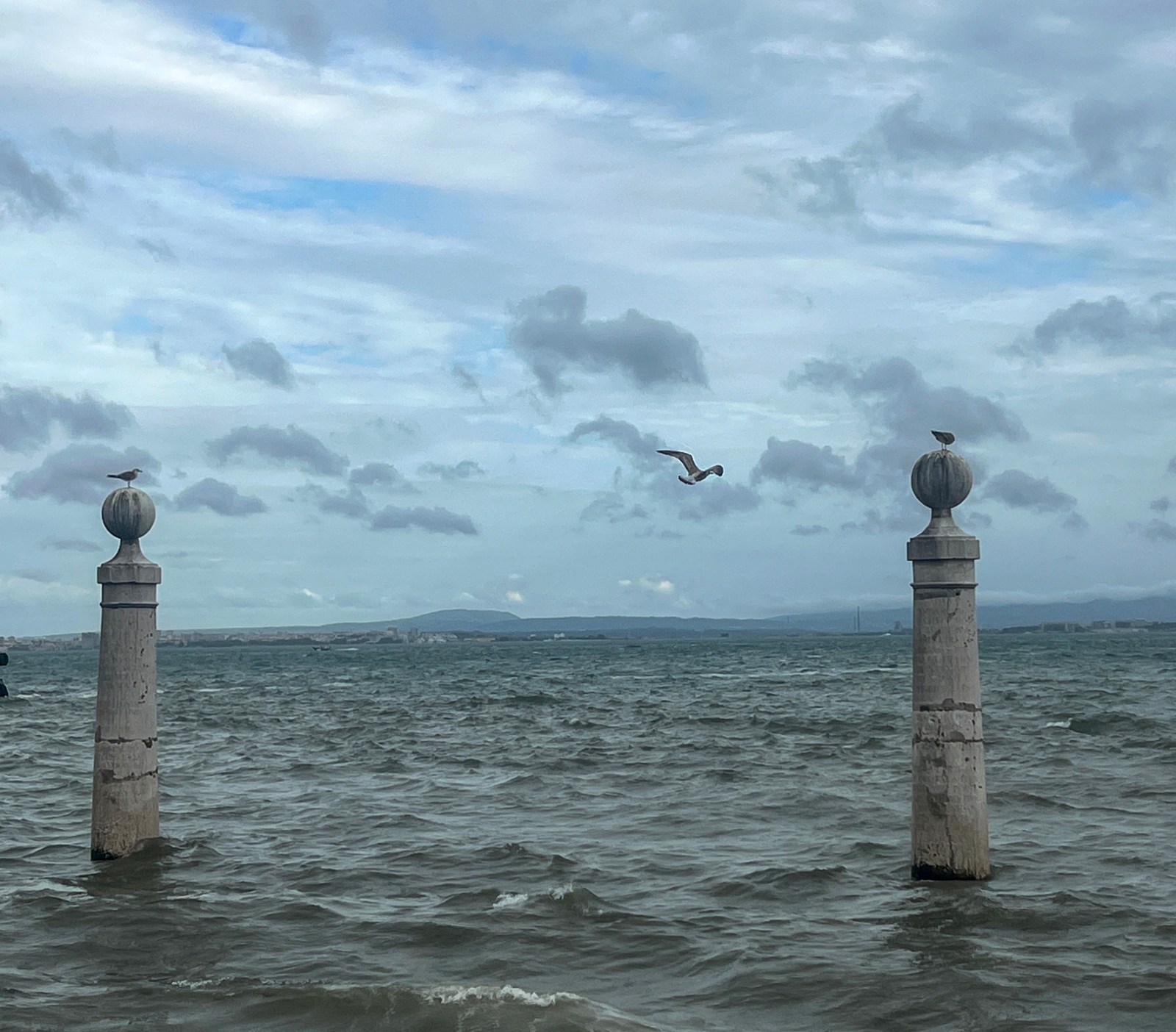
The twin pillars of the Cais das Colunas, modelled after the pillars of Solomon’s Temple, have observed history. And yes, that’s a river, not sea. (Photo: Tony Jackman)
To the right as you turn to face Lisbon, your eyes take in the 25 de Abril suspension bridge and your mind does a flip. It looks exactly like the famed Golden Gate Bridge in San Francisco, and that’s because it is, with some moderations, though is 1.5 metres longer. The Ponte 25 de Abril (originally the Salazar Bridge) is 2,277 m long and has two tiers. Below the top road deck is another which is crossed by more than 150 trains a day, ferrying residents between home and work.
Before the week was out, I would be crossing that bridge.
The Monument of the Discoverers and a castle in the sea
The day before, all of this could only be imagined. Because our eyes, our minds, and ultimately our palates, were swallowed up by Belém.
The day couldn’t have been hotter or more humid. We walked and walked and sweated and sweated. Then we queued, but luckily not for long, to be among the millions in the world who have come to Belém for a pastel de nata. But really, just one? No. You come to Belém for pastéis de nata. That is, two or more.
But first, the Torre de Belém. Or, as an entranced friend back home exclaimed when I showed him a photograph of it, “A castle in the sea!” The Torre, or Belém Tower, also known as the Tower of Saint Vincent, dates to the 16th century and, like the pillars of the Cais das Colunas further upstream and the breathtaking Terreiro do Paço, was once a place of embarkation for the Portuguese explorers, or discoverers as they are often called in Portugal; a “ceremonial gateway” as it has been called.
There’s always a long queue to go in, and as our friend and guide told us, like any castle inside it’s just walls and stone, so we were happy to settle for the gorgeous exterior aspect, set against a hot azure sky. Yachts and ferries glid gracefully here and there, near and far across the Tagus. Vendors sold sweet Brazilian pineapples called abacaxi from an ornate food truck. Tuk-tuk taxis of unusual length, like tuk-tuk stretch limos, deposited tourists and picked up others.
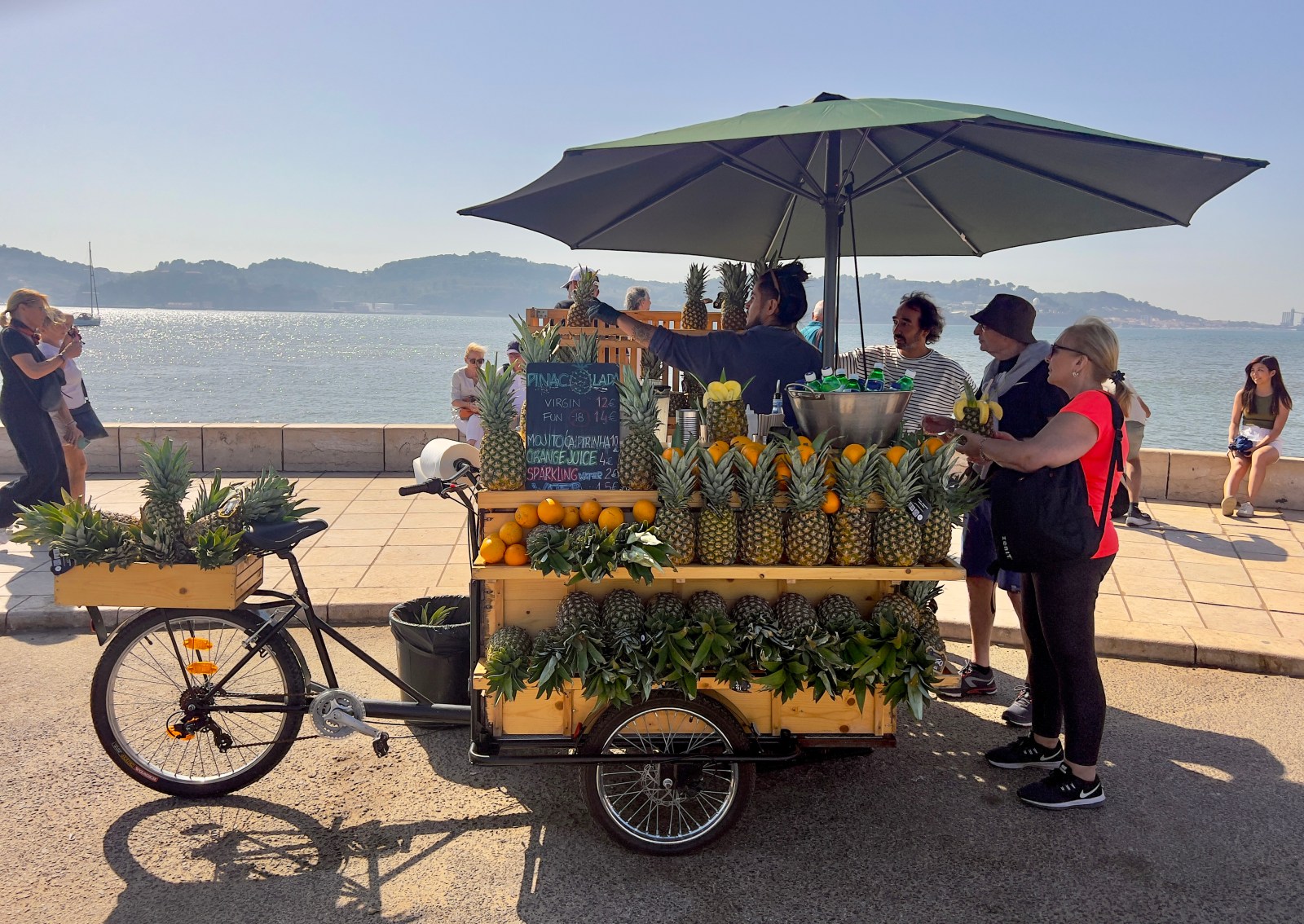
Abacaxi are the deliciously sweet and mild Brazilian pineapples that people in southern Portugal adore. This cart was on the riverside promenade in Belém. (Photo: Tony Jackman)
We turned and walked, past quays where private craft bobbed at their moorings, on and on past the Jerónimos Monastery until the Padrão dos Descobrimentos (Monument of the Discoverers) came into view and took my breath away. Inaugurated in 1960, it commemorates the Age of Discoveries in Portugal. It is huge and beautiful, a masterpiece with pride embedded in its very essence. I cannot think of a more impressive monument.
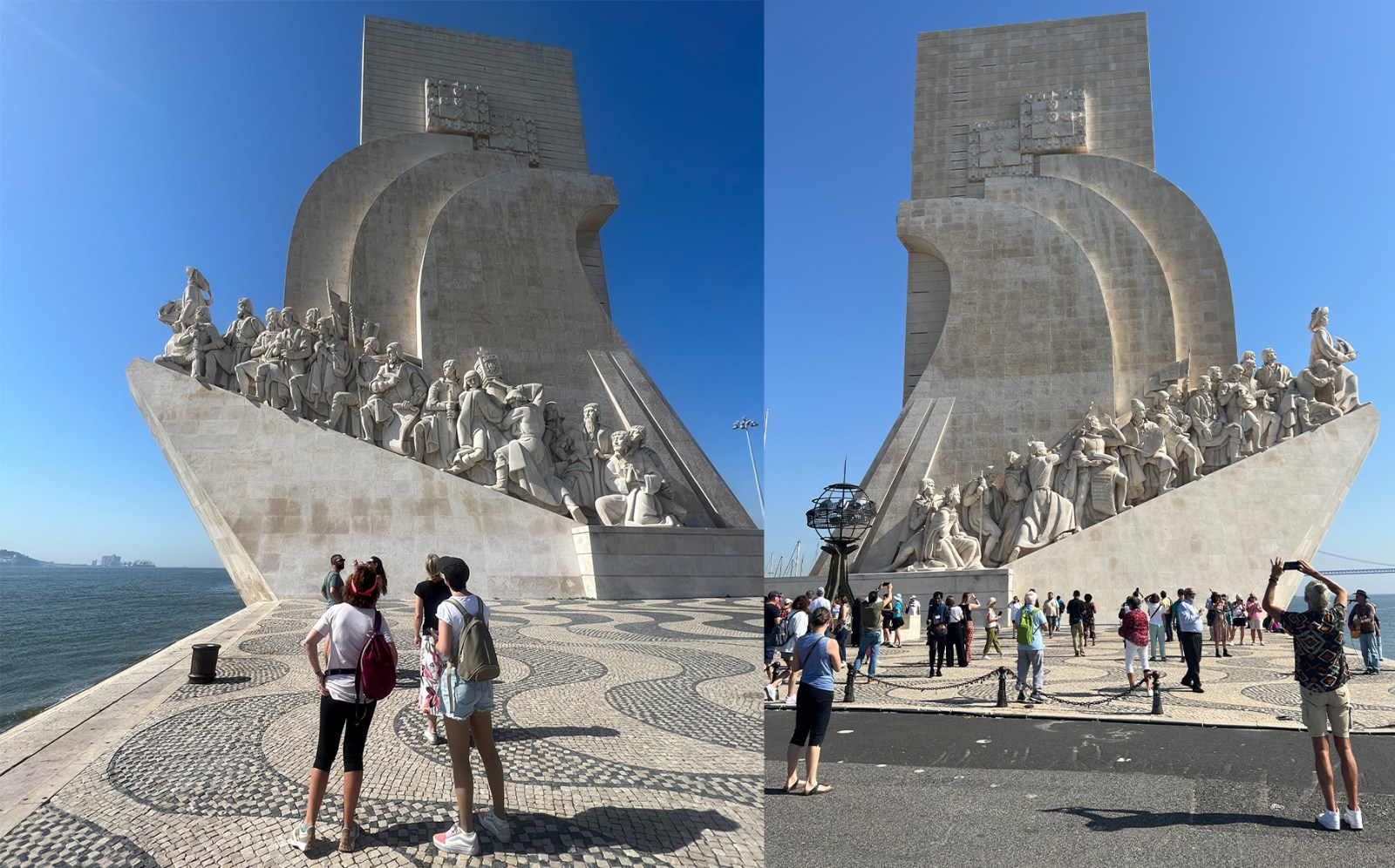
Back-to-back images of the Padrão dos Descobrimentos at nearby Belém, showing views from either side. The monument is massive, far bigger than you could imagine without seeing it up close, and has a viewing deck reached from inside. (Photos and collage: Tony Jackman)
The monument commemorates the 500th anniversary of the death of Henry the Navigator, who discovered the Azores (Açores in Portugal), Madeira and Cape Verde. On the starboard side of the prow of the caravel that the grand sculpture represents, Prince Henry the Navigator leads the way ahead of a pack of famous explorers; with more mirroring them on the port side.
It’s too easy to pass judgement on a country, and one which formerly colonised and enslaved others, from an enlightened modern perspective. When you stand at places like the Terreiro do Paço and the Padrão dos Descobrimentos, there seems to be a presumptuousness about doing so. Who are we to say that the wise old Portugal of the 21st century is no different from the wide-eyed nation of hundreds of years ago desperate to conquer?
Many will have their own thoughts, undoubtedly, but I do wonder if, standing there as I did, they would not find pause for thought.
Had nature not already wrought her vengeance on the city in that 1755 earthquake?
As it happens, there are counterpoints to these celebrations of past glories, such as a grim museum exploring the slave trade, and an impending new monument, depicting rows of sugarcane painted black, which is slated to be situated near the Padrão dos Descobrimentos.
Balance is to be brought to the history on display.
Pastéis de nata, travesseiros and chamuças
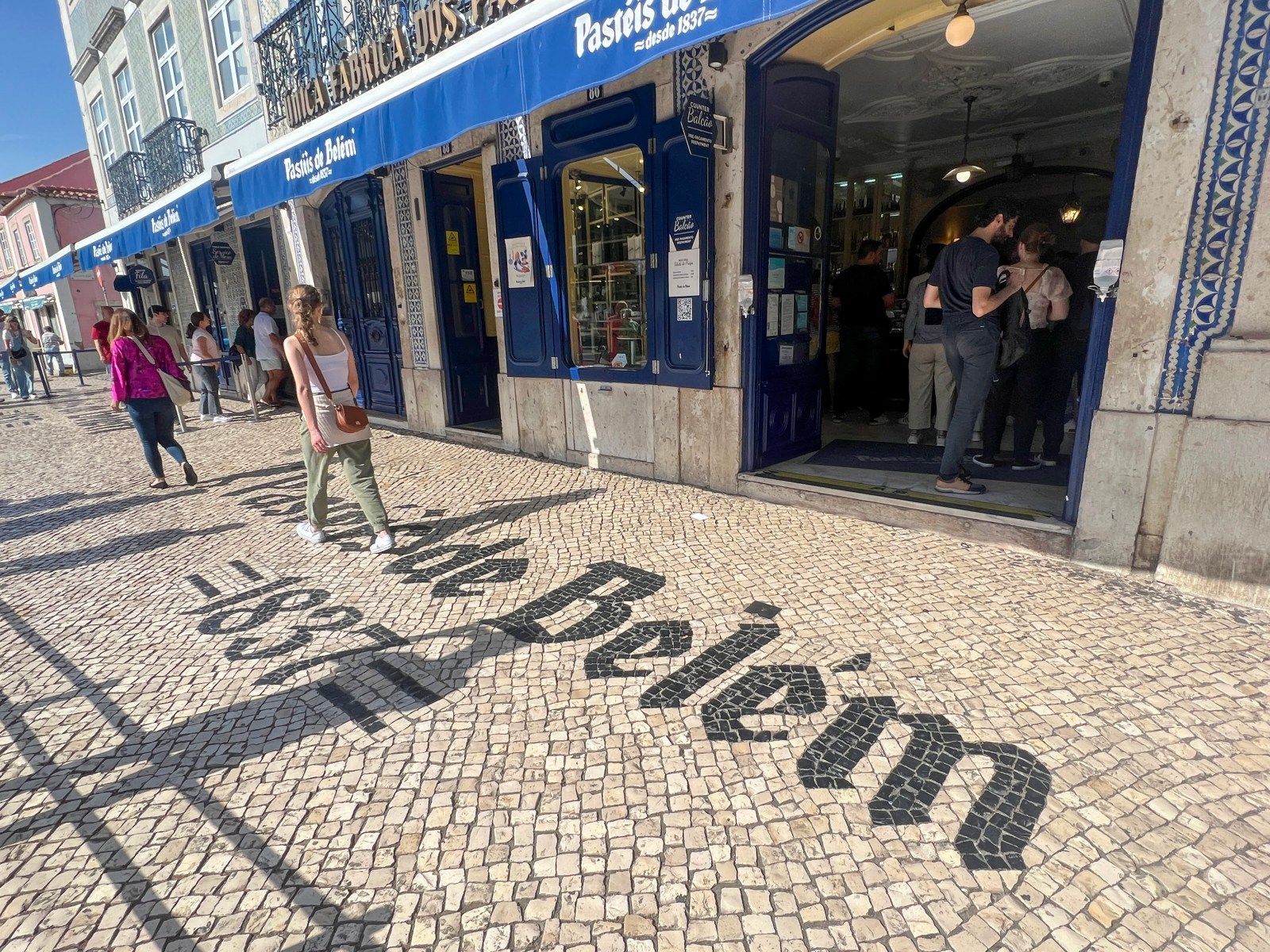
Your welcome to Pastéis de Belém begins on the pavement. (Photo: Tony Jackman)
To assuage history and return to the present, we joined the queue at Pastéis de Belém, not the takeaway queue at one end, or the pre-order queue at the other, but the queue in the middle to sit down and eat our pastéis de nata.
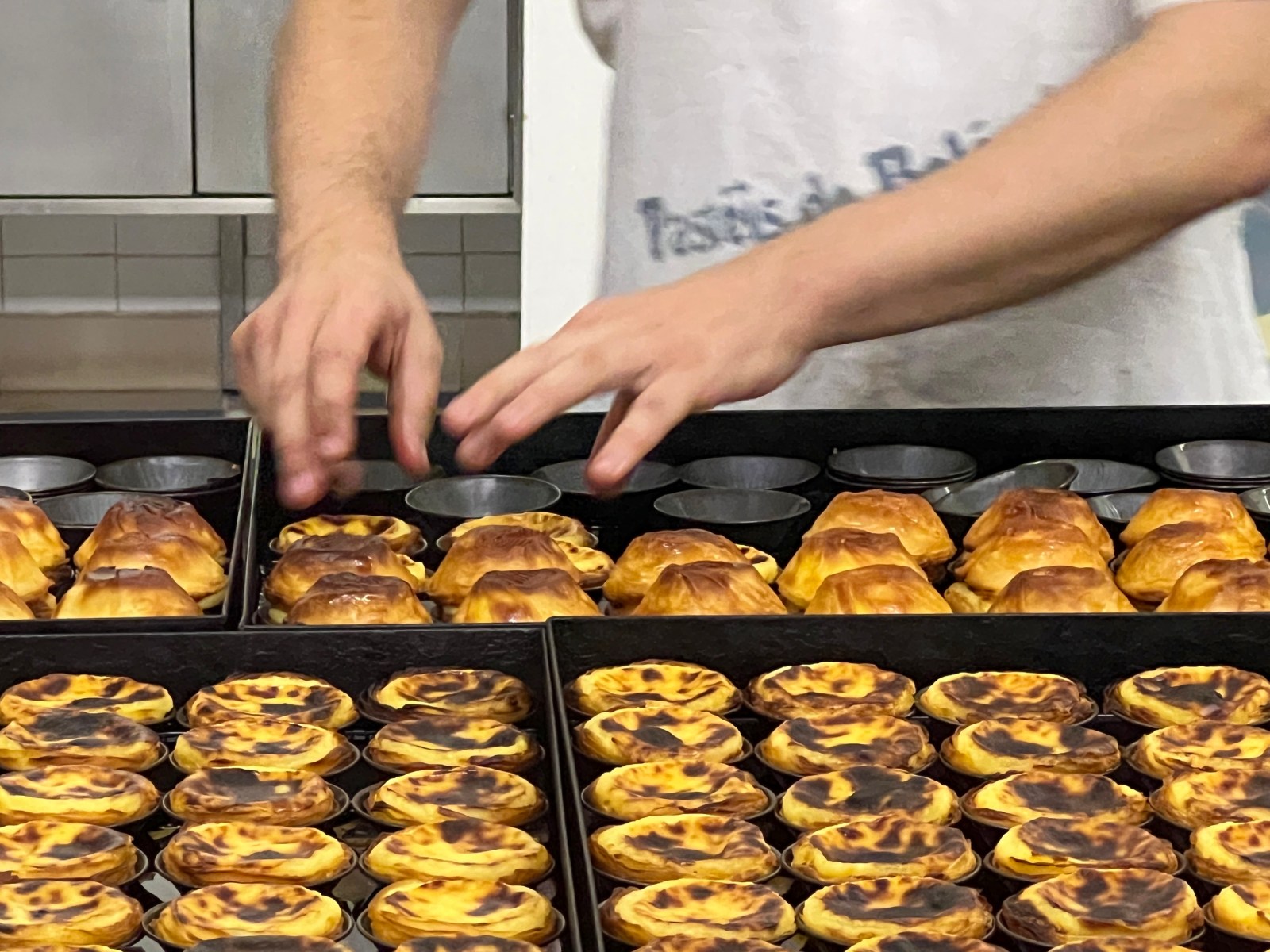
A chef turns over some of the endless production of pastéis de nata that seems to never end. (Photo: Tony Jackman)
But they don’t only sell pastéis de nata at Pastéis de Belém. We also ate a nutty travesseiro, which is a speciality of Sintra, a pillowy concoction with a creamy almond filling. Glass cabinets near one entrance displayed slices of mil-folhas (puff pastry with fondant icing), tosta de laranja (moist orange rolls), and babá cupcakes.
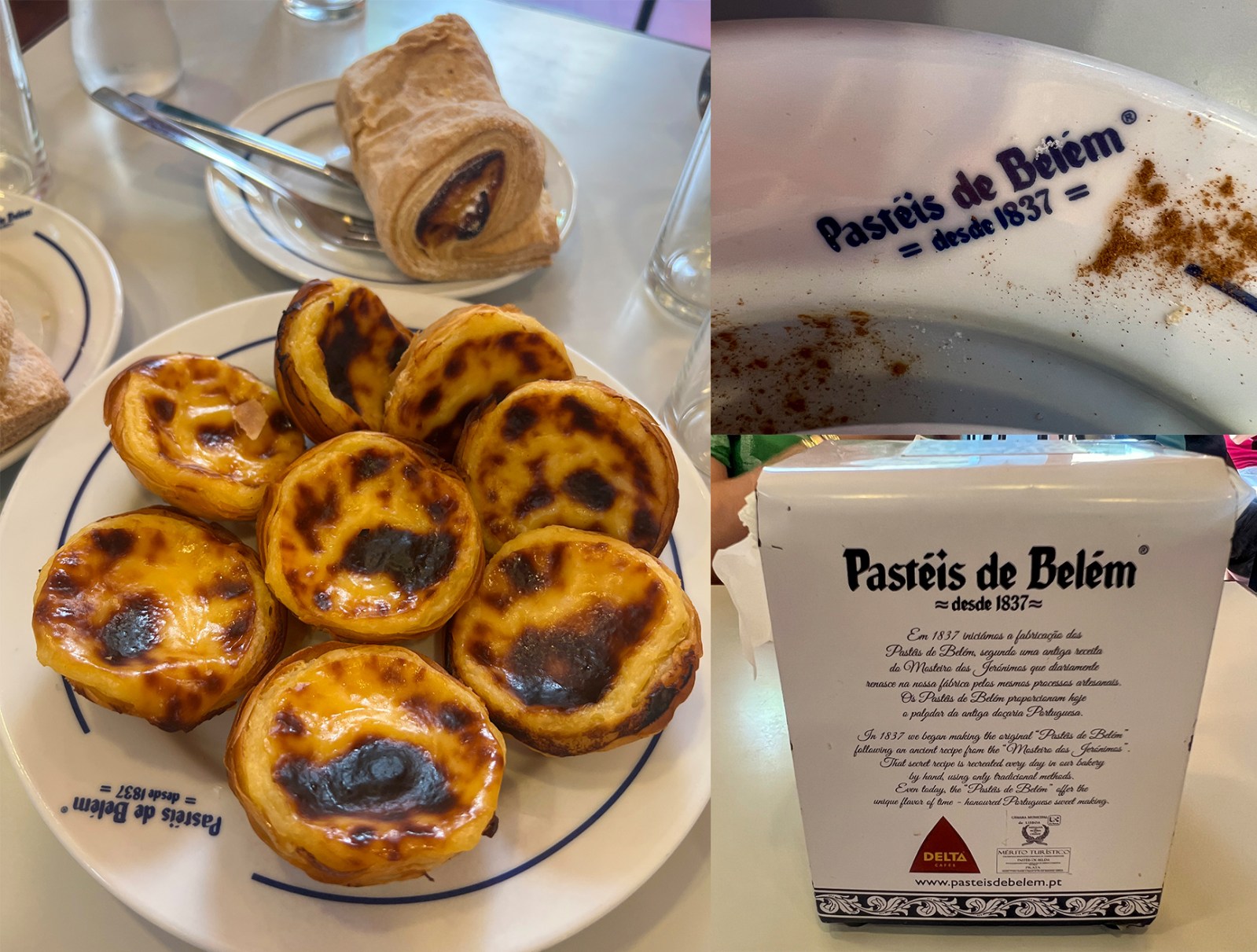
Pastéis de nata at the cafe where they originated near the Tagus River in Belém, Lisbon. One is a pastel, two or more are pastéis. (Photos and collage: Tony Jackman)
I ate other pastéis de nata elsewhere, but none came close to this original with its sweetly blackened top. There are savouries too, some with presunto (Iberian ham), others with queijo (cheese) of one variety or another. Treats sold here and all over the region include pastéis de bacalhau (codfish fritters), rissóls (in this case, a deep-fried prawn turnover), and chamuças (samoosas).
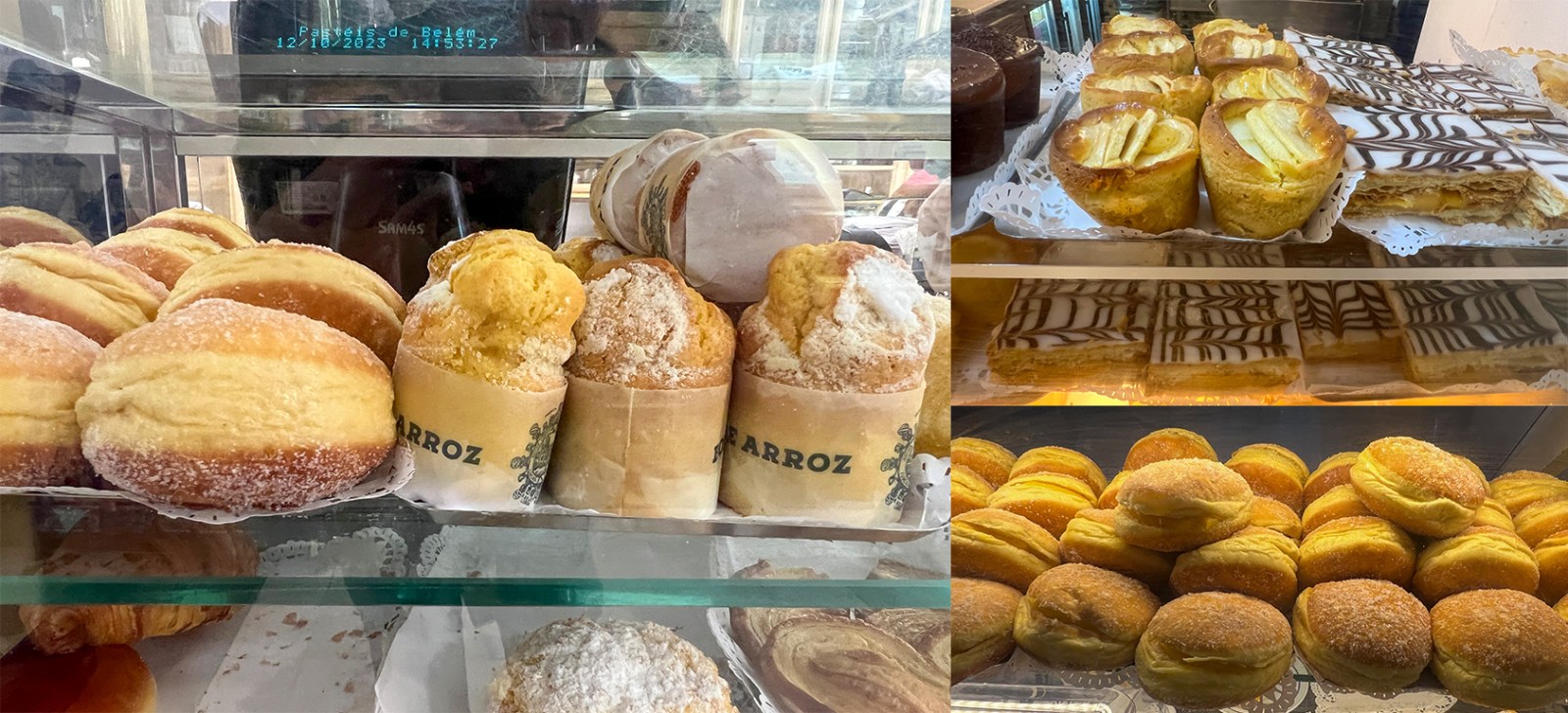
There’s more than pastéis de nata at Pastéis de Belém. Delicious confections include bolo de arroz (rice flour cakes), apple tarts and bola de berlim (doughnut pastries). (Photos and collage: Tony Jackman)
It’s that crunchy, spicy delight that everyone claims as their own. Even though its origins are in Southeast Asia, to a Capetonian a samoosa (and we insist on adding an “o”) is as much a part of the city’s soul as Table Mountain itself. But in Portugal it’s a chamuça, a name that makes it sound as local as a fried sardine.
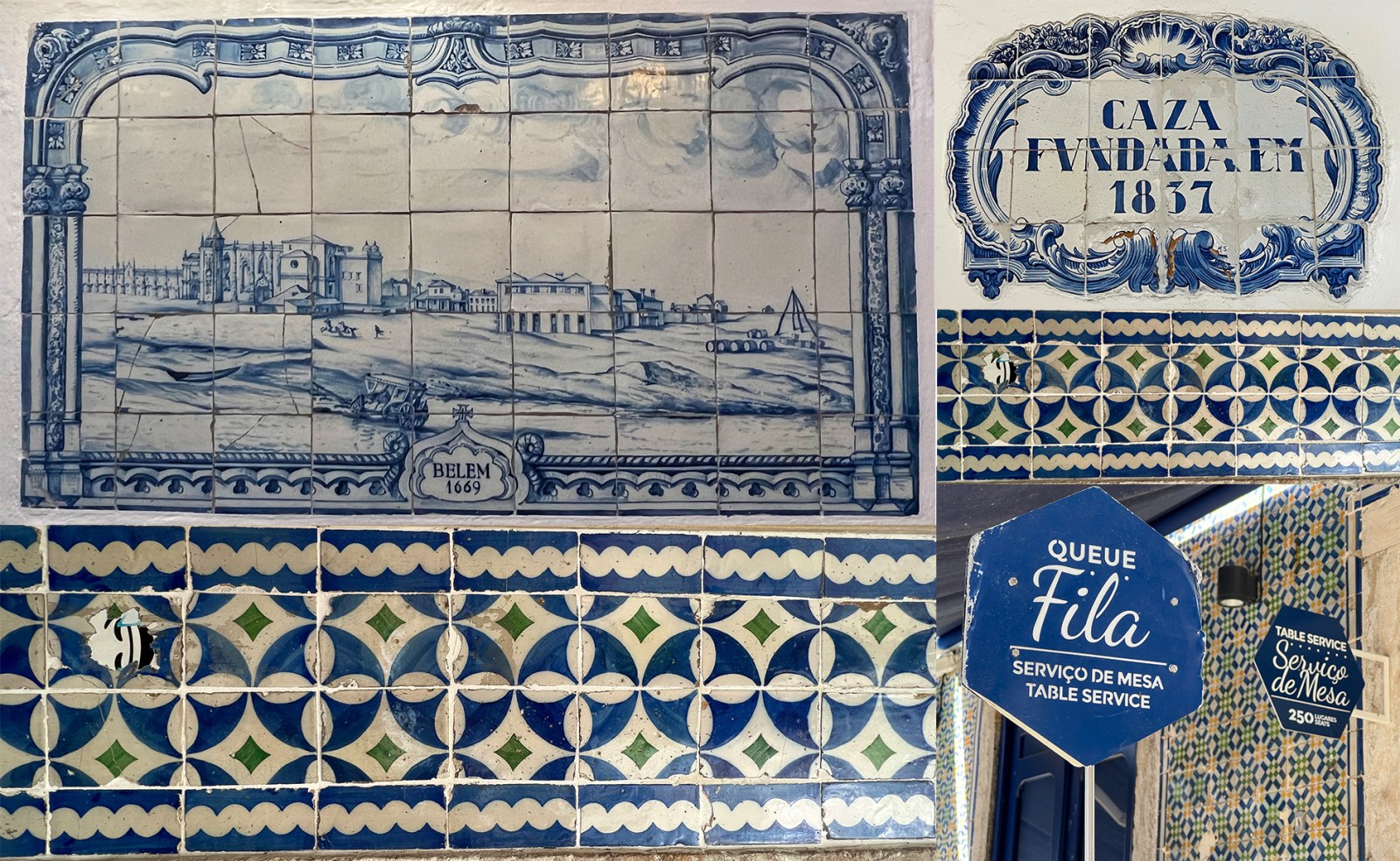
Azulejo tilework in Pastéis de Belém showing the area in 1669. Another azulejo celebrates the year the house was built. The ‘fila’ sign tells you to queue here, though there are two other queues. The border shows the signature tile of the café. (Photos and collage: Tony Jackman)
The blue and white tiles you see all over Portugal, on the walls of houses, on entire triple-storey apartment blocks, even on street signs, are all over the exterior and interior of this world-famous shop. Scenes of the neighbourhood in ancient times. The legend “Casa fundada em 1837” explains the building’s vintage in tiles. Another assemblage in blue and gold tiles frames a passage by Luís Vaz de Camões, from his epic poem “O Lusíadas”, on the departure of Vasco da Gama: We thus depart from the holy temple…
Camões is everywhere here, like pastéis de nata and countless gorgeous tiles. Fernando Pessoa, the poet and philosopher, is everywhere too. I even had my photograph taken with him in Lisbon.
And suddenly, the dots are connected
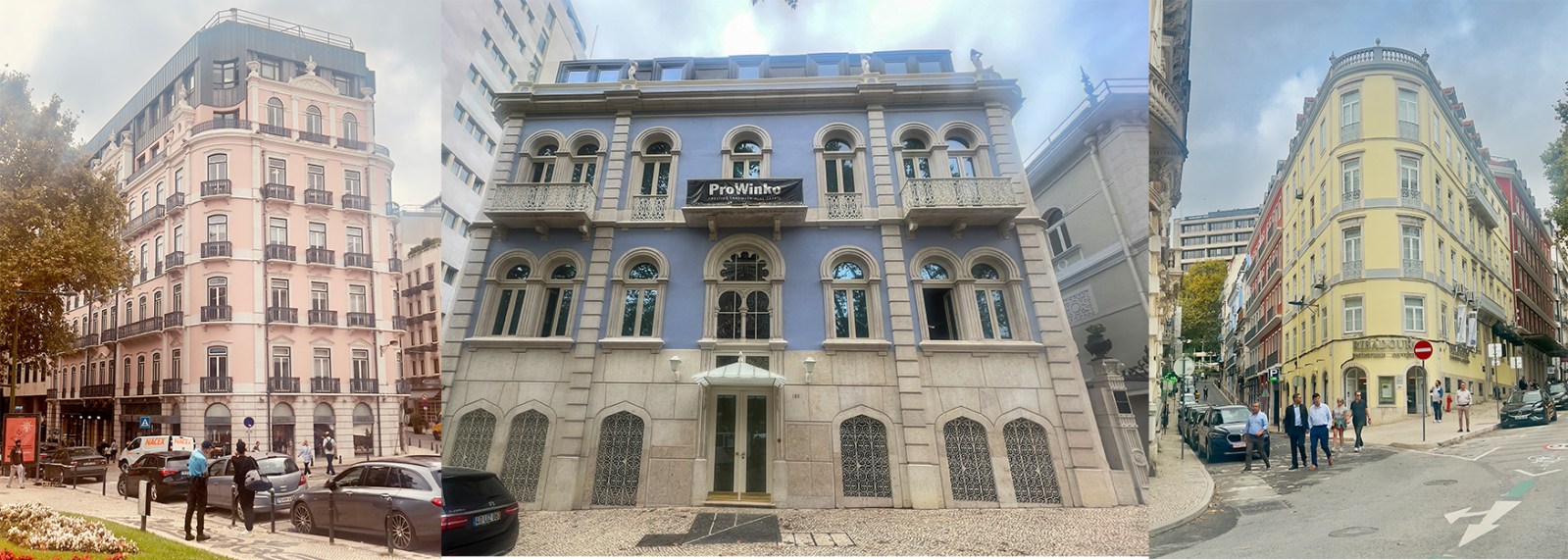
Just three of the magnificent buildings on Avenida da Liberdade in central Lisbon. Beautiful tiled façades abound. (Photos and collage: Tony Jackman)
Before that heart-stopping moment when I first walked onto the Terreiro do Paço, we had been on Avenue Liberdade, a grand boulevard that runs through Lisbon. At Banana Cafe, one of the many quiosques (kiosks, how clunky it spells in English) that dot the tree-lined central island that runs the length of the avenue, I ordered a lemonade. It turned out to be a glass of tap water with a bit of lemon juice squeezed into it. But it mattered not, as my real nourishment came from admiring and photographing building after building awash with tiles of many hues and patterns.
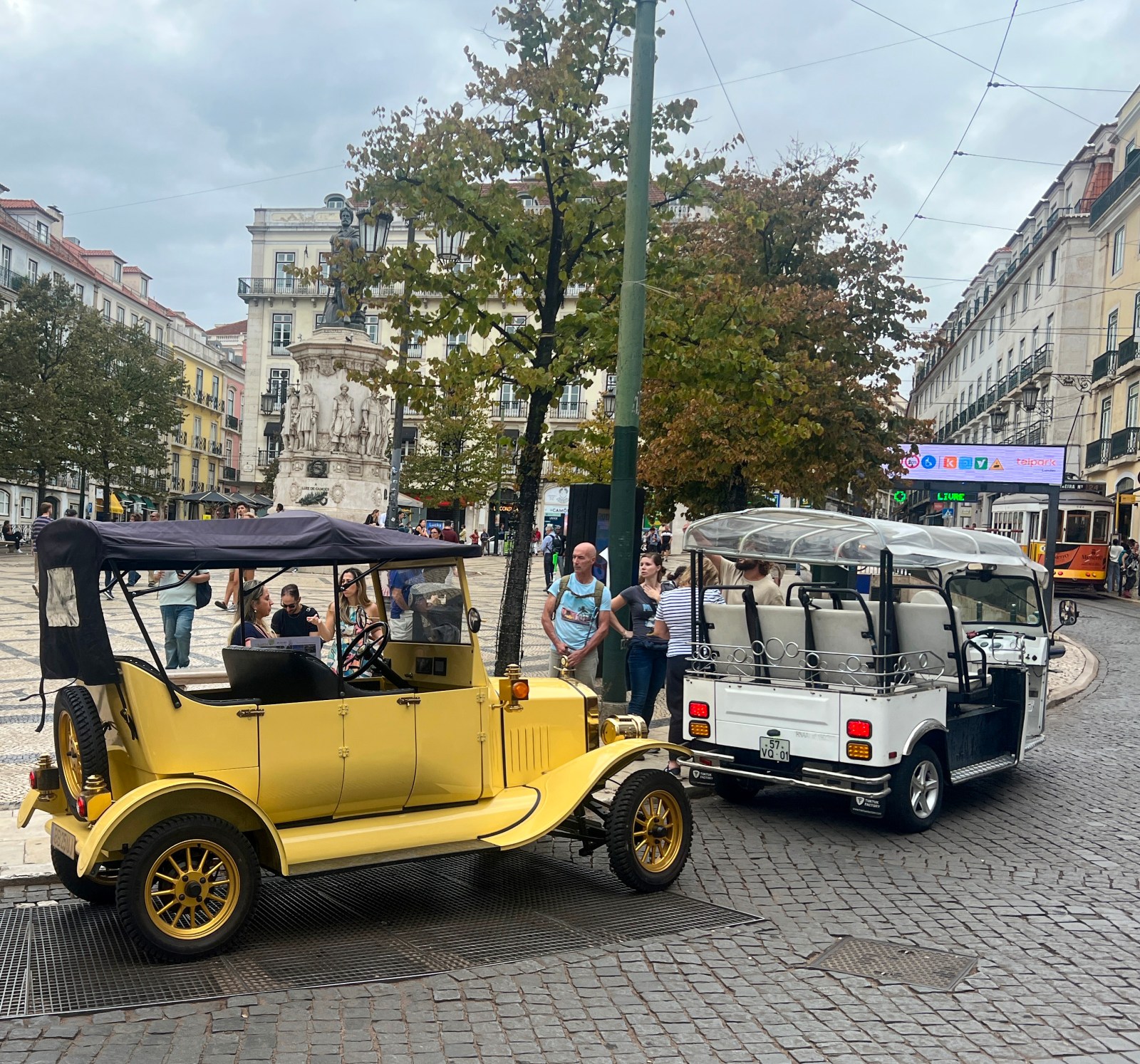
Replicas of Model T Ford motorcars and other vintage models are all over Lisbon. (Photo: Tony Jackman)
We met up with our host who drove us expertly to Chiado, the pulse of the city’s shopping and theatre life. Parking in a basement, we walked up a flight of stairs and through a door to find ourselves right on the Praça Luís de Camões with its central statue of the poet. Electric tuk tuks tuk-tukked by. Model T Ford replicas of many colours beamed at us as they deposited their customers at the pavement to swish into stores and cafés.
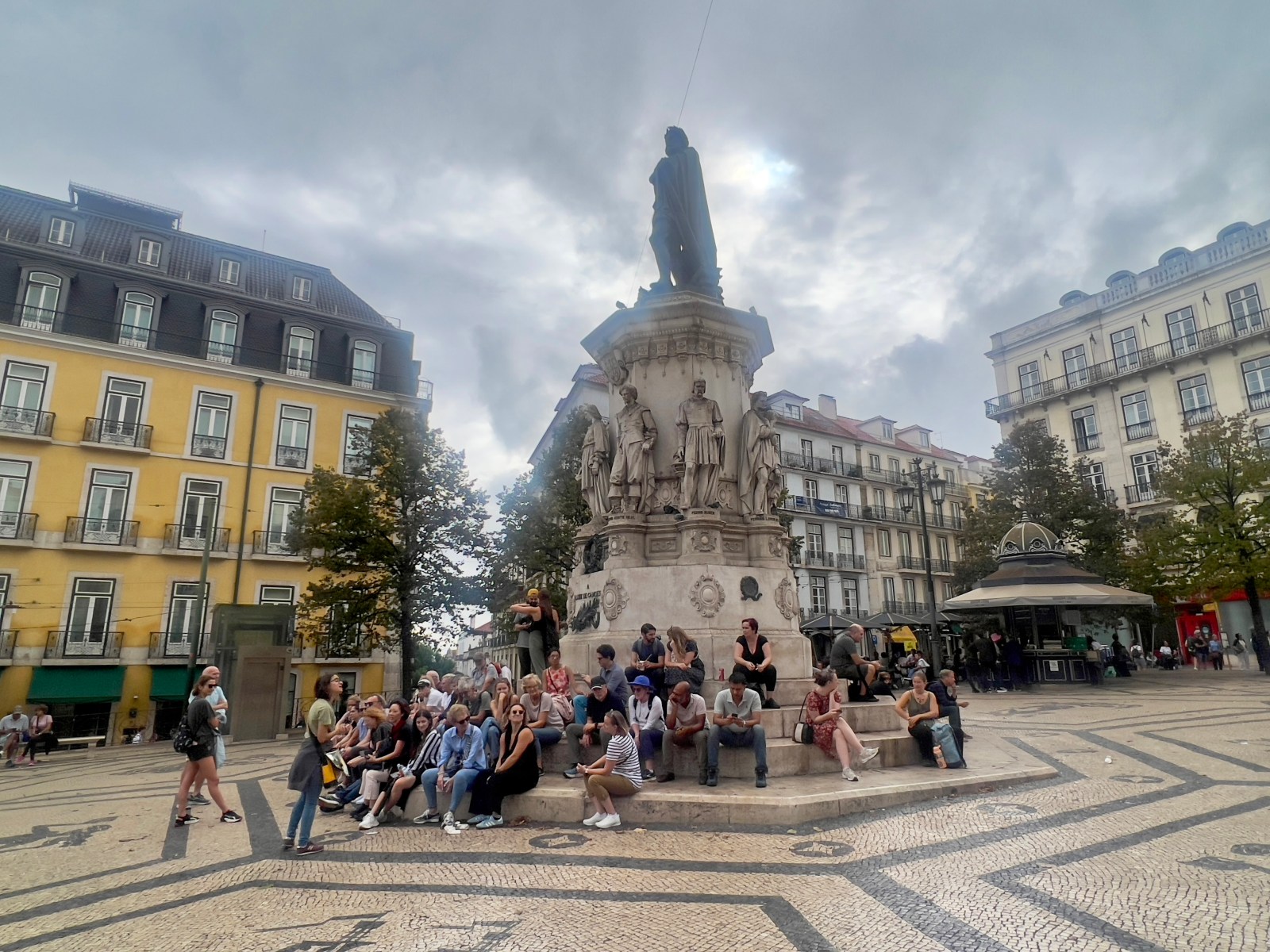
The Praça Luís de Camões with its central statue of the poet. (Photo: Tony Jackman)
We found a candle store that friends had been telling us about. A candle lover’s Aladdin’s Cave. Emerald greens, cobalt blues, candles shaped into pears and mangoes. My hopes of seeing more and buying some were thwarted when the shop assistant explained that we were not allowed to go beyond the front counter to the magnificent glass cabinets we could see behind her. How can you choose if you can’t explore? Can’t have every Tony, Dick and Harry going in there, evidently. I do understand though: I had not seen a no-photography sign and had started to photograph candles, until she stopped me. She thought I was just one of the many annoying tourists who only want to photograph everything.
At Restaurante Benard in Chiado, you can’t take photographs either. Even of the menu (my way of recording where I’ve been and what I’ve eaten). Even when I explained that I write about food for a living. No.
I ate a pastel de bacalhau (codfish parcel) and a shrimp rissol. I was nibbling a pastel de nata, not a very good one, when a very smart octogenarian couple sat down at a table near us. He was in an old-fashioned suit, white shirt and tie. Very Lisbon Old Boys’ Club. Her hair was neatly permed, pearls at her neck and ears. Wore a tidy two-piece suit. They’d stepped right out of the Seventies. They spoke quietly to one another and looked neither left nor right. They were typical, our host told us, of old-school Lisbon society. It was a kind of tiny insight, a mysterious little window, onto a whole world of another Lisbon, one we can only wonder about.
The dots were quickly connected. People like these stalwarts of the old city must have been coming to Restaurante Benard all their lives. They would have known these streets and these cafés long before the tourists came in the massive numbers they are now and swished around photographing everything in sight, having their picture taken with the beloved poet Fernando Pessoa (I did, mea culpa), filling the Terreiro do Paço and Pastéis de Belém with their jabbering in every tongue, their presumption about the city’s old politics, and their eyes on stalks.
And here, now, who are all these people?
Coda
I learnt many words in those few short days in Lisbon and Cascais, in Évora and Sintra. But the word I treasure most is saudade. A longing from the depths of the soul. The kind of longing I have to return, so that I can know Lisbon as well as that genteel old couple who are probably sitting in that café right now, oblivious of us all. DM
Find Part 2 of this four-part series here, on Évora, and the third here, centred on Cascais.
Tony Jackman is Galliova Food Writer 2023, jointly with TGIFood columnist Anna Trapido.
Follow Tony Jackman on Instagram @tony_jackman_cooks.






 Become an Insider
Become an Insider
We loved this article as it totally resonates with all we feel about living here for six months each year and in Cape Town for the other six. The history of Portugal is fascinating and the people are just so engaging and generous. Many more South Africans are enjoying the experience
I spent many happy years in Portgual, with frequent visits to Lisboa. The food was always wonderful, and I even grew to appreciate fado, the mournful folk music, but the pervasive memory after over 30 years away is the calçadas (cobbles). They were (and are) everywhere. Back in the seventies, it was de rigeur to wear high-heeled shoes. Calçadas eat high-heeled shoes the way Lisboetas eat pasteis! But they are magnificently beautiful, and the mestre calceteiro is an artist of note. Thanks for the memories, Mr Jackman!
Fernando Pessoa is a Durban High School Old Boy!
Thank you so much Tony! Such glorious memories of my too short visit to Lisbon.
Planning to do the Portuguese Camino before I keel over.
Listen to MADREDEUS while reading this and the next 2 articles. Madredeus is the soul of Lisbon